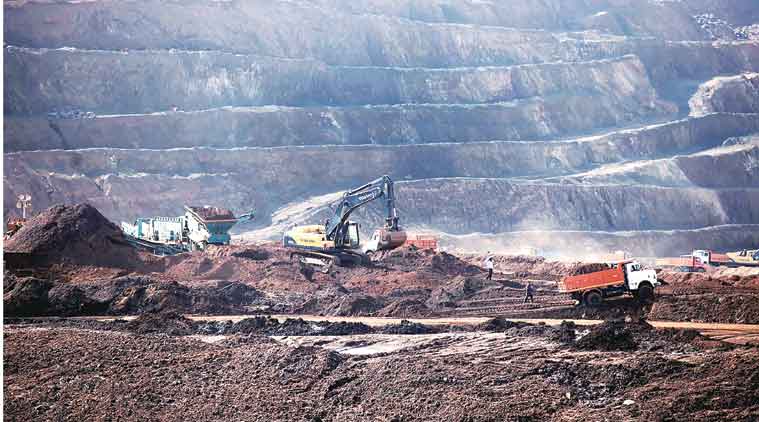Date | Nov 16, 2016:

International Data Corporation (IDC) did a survey in 2015 of 190 mining companies, where it found that “mining companies are looking to a future where technology is changing the operations of the mine”.
The Centre has decided to give a major thrust to the use of unmanned aerial vehicles (UAVs) — commonly known as drones— in order to increase the efficiency of various aspects of mining sector such as plan preparation, area inspection and mineral exploration.
While the Union mines ministry in its November 1 letter to all state governments and public sector units (PSUs) involved in mining asked to “explore the usage and deployment of drone technology in your respective organisations”, it has already asked its exploration company — Mineral Exploration Corporation Limited (MECL) — to buy one or two drones and start using them so that others can see the benefits themselves.
“I have asked the MECL to buy one or two state-of-the-art drones, which can do most of the stuff such as mining plan, geo-referencing, inspections etc. Once these drones are purchased, MECL would be free to lend them to other organisations such as Geological Survey of India (GSI) and Indian Bureau of Mines (IBM),” said Balvinder Kumar, secretary, Ministry of Mines to The Indian Express. All three organisations — MECL, GSI and IBM — work under Ministry of Mines.
“Now, if a (mining) plan has to be prepared for a 100 square kilometer area, the drone can do a broad survey of the whole area, along with its geology, within 8 or 10 days. The same work, if done manually, takes two to three months,” he added.
The mines ministry, however, is yet to receive any reply to the November 1 letter written to states and public sector units such as National Aluminium Company (NALCO), Hindustan Copper Limited (HCL), National Mineral Development Corporation (NMDC), Steel Authority of India Limited (SAIL), Rashtriya Ispat Nigam Limited (RINL), Mineral Exploration Corporation Limited (MECL), Bharat Gold Mines Limited (BGML) and MOIL (formerly known as Manganese Ore India Limited). In its letter, the mines ministry had specifically asked the states and these companies to “share the action taken in this regard with the ministry”.
The mines ministry, however, is undeterred. A few days ago, Kumar received a presentation from IIT Kanpur that talked about how the drones can provide all kind of services and how they can be designed as per a mining organisation’s requirements.
“They (IIT Kanpur) talked about how we can take a high quality picture from above and we can easily analyse the area belonging to dumps or to the green area. They also talked about how the inspection of an area can be done with the help of drones. We don’t need to go there physically. Also, we can assess the production by seeing the depth to which the miner has gone to. So, if the miner tells us that if he has taken out 10,000 tonne of mineral, we can easily check it through the images,” Kumar said.
“Another area, which they believe can be checked is illegal mining. For example, to help catch illegal sand mining, they told us that the drone can go to 5 km in one direction on a river bed. This means that a 10 km stretch can be observed by drone,” he added.
Globally, the use of drones in the mining sector has already begun. Rio Tinto, one of the world’s largest mining company has already been using drones to survey its mining pits and use of equipment in Western Australia.
International Data Corporation (IDC), a global market intelligence firm, did a survey in 2015 of 190 mining companies across the world, where it found that “mining companies are looking to a future where technology is changing the operations of the mine.” Its research showed that 69 per cent of mining companies globally are looking at remote operation and monitoring centers, 56 per cent at new mine methods, 29 per cent at robotics and 27 per cent at unmanned drones. IDC found 83 per cent of mining companies saying that their technology budgets will increase or stay the same in 2015.
Talking about the global use of drones in mining sector, Kumar told this newspaper: “I am sure that other countries must be using it already. I have not seen it personally. If our IIT is guiding us on this issue, then I am sure that other countries must be using it already in the mining sector. Nowadays, high resolution drones have already come in mining sector which gives us the exact picture on the ground.”
“With fewer man hours required to produce large, accurate data sets, and no need for externally sourced imagery, the result is vastly reduced costs. In fact, many operators report that a single imaging drone — comparable in price to a mid-range GPS rover — can pay for itself in just a few months,” said the November 1 letter of Union mines ministry.
MECL is set to use the drones, the government is pushing other PSUs to use them, government believes that it is now affordable and drones’ usage globally in this sector is already increasing. All these factors may lead to the technology’s widespread use in the Indian mining sector. However, with mineral demand not up to the required levels, which can be observed from the lukewarm response of the Indian companies to the ongoing non-coal mining auction, it remains to be seen if they would move quickly to adopt drones.
(Source: http://indianexpress.com/)